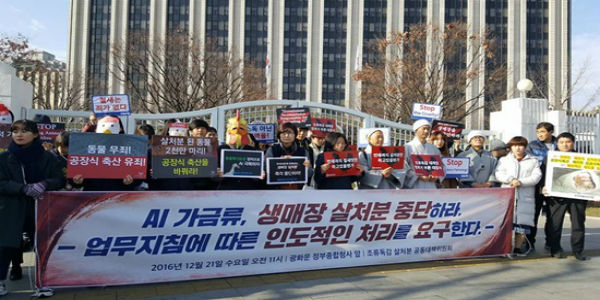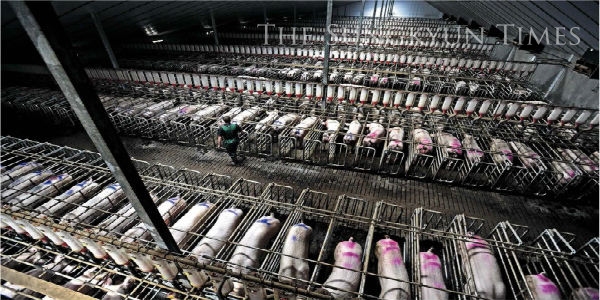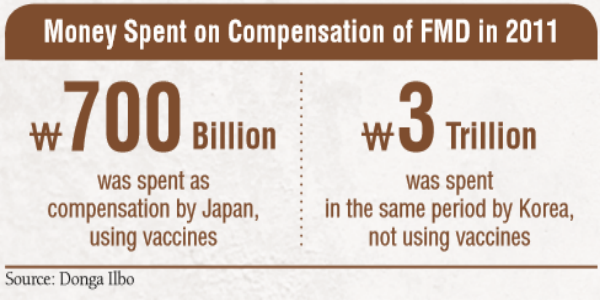Avian Influenza (AI) and its spread are reported on a daily basis these days, but the Korean government’s only actual response to this epidemic has been mass culling. 33 million poultry animals in Korea are known to have been culled in less than half a year since the first reports of AI, and the number is still growing. Considering that Japan, Germany, and France have all successfully performed AI control with less than one million birds culled in the same period, it is easy to see that Korea’s 33 million slaughtered poultry animals is an abnormal figure. Contagious diseases have troubled Korea for many years with different variations that show no sign of lessening, so long-term measures need to be planned and carried out. The Sungkyun Times (SKT) now covers the culling issues in Korea and the reformations that need to take place in various fields of disease control.
Mass Culling of Livestock in Korea
Spread of Foot-and-Mouth Disease and Avian Influenza
Mass culling of livestock in Korea first started as Foot-and-Mouth Disease (FMD) contaminated huge numbers of cattle in 2011. FMD is a disease that causes high fever along with blisters on the feet and mouths of cattle, hence its name. It is among the most dangerous of animal diseases with a death rate of 55% and has resulted in 3.5 million dead cattle in Korea. FMD has been found in Korea again recently, worrying many farmers and government officials and reminding them of the calamity that took place years ago. AI is a major issue in Korea these days with new outbreaks in different regions being reported relentlessly. AI, also known as bird flu, induces fever and respiratory complications in birds which have led to mortality rates of 80%. Migratory birds are known to be the main cause of AI spread and have been a constant problem in Korea since its first outbreak in 2006. According to Yonhap News, AI has caused its greatest damage in Korea lately with over 33 million birds culled.
Korea’s Culling Method
FMD and AI naturally led to a mass culling of livestock in Korea, which used to be carried out by burying animals alive. Burying livestock alive was the standard procedure of culling until 2014 when amendments to the animal protection law were made. Since then, it has been a requirement to administer euthanasia on livestock and check their levels of consciousness before burial. Small livestock such as chicken or ducks are asphyxiated with carbon dioxide, and large livestock such as cows or pigs are euthanized by giving the animals shots. After the animals are killed and buried, unauthorized use of the burial sites is strictly prohibited for three years.
Losses Due to Mass Culling
Economic Losses
With many years of unrest from FMD and AI, Korea has suffered from losses in various fields. Economic loss is one of the most serious losses as it affects numerous interest groups at once. Firstly, the government spent about 3 trillion on culling expenses and compensation to the farms in the FMD crisis of 2011, according to the Donga Ilbo. An additional 360 billion is also expected to be used for compensation of the recent AI culling. Another group of people with serious financial losses are the breeding farmers who have suffered due to the government’s idle cost estimation. Korea’s farming system is generally composed of a major company that owns the farms and the breeders who do the actual work. For instance, the Korean chicken company, Harim, pays breeders 500 to raise them. In truth, the farmers that are known to the general public only have that payment to live on. When the recent AI spread took its catastrophic toll, however, the Korean government only gave the breeding farmers 130 out of the 500 they deserved. Many farmers were frustrated at the low compensation and believed the government’s idle cost estimation was to blame. Last but not least, ordinary citizens also experienced these economic losses when prices of poultry products rose dramatically. Rises in egg prices were surprising in particular because they became about twice as much as they used to cost.
Decaying Lands in Korea



The titles of the photographs above are 299, 11800, and 84879 respectively. They represent the number of animals that were slaughtered and buried in those sites. What happened to the land was appalling. Photographer Moon Sun-Hee mentioned, “I could smell the rotting livestock even though it was three years since they were slaughtered. The ground was soft, but in a very unpleasant way. I also saw pig skulls sticking out of the ground.” What she saw was the result of 10 million buried livestock animals rotting away. The color of the land had turned yellow, purple, white and other unnatural colors, with fungi and white liquid capping the earth. Unrecognizable vegetation was growing and dwindling at the same time. The pig skulls that she saw were due to the insufficient depth of burial. The manual for culling in Korea states that all animals must be buried three meters deep, but this was not thoroughly completed because it was winter and it was too hard to dig that deep. Three years is all it took for the burial sites to deteriorate, but Korea is still not stopping the mass culling of birds, with 33 million recently put beneath the ground.
Ethical Issues of Mass Culling

Ethical issues of mass culling are now surfacing more than ever because of the recent AI. Animal protection organizations gathered together and held a press conference to criticize the current culling policy on February 22nd, 2017. They were enraged by the fact that 81 million animals have been slaughtered for disease control in the last 10 years, and that the government took no other actions to prevent infections in advance. They demanded measures to reduce Korea’s factory farming system and to establish a thorough disease control system. Moreover, the organizations claimed that not many animals were euthanized before burial. During the asphyxiation process the animals’ level of consciousness was not checked well because there were too many animals culled at one time, as was confirmed by Yonhap News. This brought up controversies other than ones related to animal ethics as well. The manpower needed for mass culling cannot be sufficed by volunteers alone. Naturally, the culling task is forced upon groups of people such as soldiers or public officials. Not to mention this coercion is a problem in itself, it is even more mentally stressful for workers if animals are being buried while they are still conscious. The culling task recently forced on soldiers infuriated families and had a bad reaction from the public in particular, for there were countless disputes regarding this matter many times before.
Changes to be Made before Mass Culling
Mass culling of livestock is not the best choice of disease control in terms of economy, environment, and ethics. There are improvements that should have been made in various fields long ago to reduce the spread of diseases beforehand.
Korea’s Factory Farming System

One of the biggest amendments to be made is one regarding Korea’s factory farming system. The factory farming system refers to a system of breeding that does not give animals freedom, but cages them up and breeds them like machines in a factory. For instance, pigs are kept in small cages called sow stalls, and chickens are kept in pens called battery cages. Korea’s Ministry of Agriculture, Food, and Rural Affairs (MAFRA) has been encouraging the factory farming system since 1994 due to its advantages in productivity. According to Korean Animal Rights Advocates (KARA), an animal protection organization, the number of farms has decreased but productivity has increased by 49 times over the last 20 years as a result. While this seems impressive, the factory farming system is a fatal factor that makes Korea vulnerable to animal diseases.
Drawbacks of Factory Farming
First of all, pigs and chickens kept in small cages are likely to develop chronic stress. Pigs are forced to breed through artificial insemination and when their reproductive rate diminishes, they are caged and made ready to be slaughtered for meat. Chickens’ battery cages are smaller than a piece of A4 paper. In such a cramped space, chickens show signs of severe stress with symptoms such as weakened bones or self-harm, through pecking themselves. Animals raised with chronic stress issues have higher chances of being unhealthy. As a matter of fact, out of the 33 million poultry that were recently culled due to infection, only 10,000 were from farms that did not practice factory farming. According to the Joongang Ilbo, the infection rate had a big difference as well. The infection rate of poultry from factory farms was 32.1% while poultry from other farms showed an infection rate of 1.1%. Being restricted to small spaces meant easier contamination of diseases.
Movements to Ban Factory Farming


Other countries from around the world already knew these drawbacks and showed an international movement to ban factory farming. The 28 nations of the Europe Union (EU) have banned the use of sow stalls and battery cages since 2013, while Korea still encourages this system and suffers from animal diseases. Korea should participate in this movement of reducing factory farms even though it means productivity will not be as high as before. After all, high productivity does not have much meaning if it means annual massive burials.
Domestic Production of Vaccines After the first mass culling took place in 2011, the Korean government declared that FMD vaccines will be produced domestically by 2015. This did not come to be, however, as Korea still depends on imported FMD vaccines. In fact, the only progress until now was the establishment of the Foot-and-Mouth Disease Vaccine Research Center in 2015, with nine researchers in total. This was not enough to localize vaccines and as a result, 90 billion is still used to import FMD vaccines every year. The government has always turned half-hearted when the infections came to an end and never completed the localization.

Korea does not feel strongly about the need for vaccines compared to other countries, as past cases show. When FMD was at its worst in Korea, Japan had to deal with the disease as well. Japan invested large amounts of money for vaccines back then, but Korea felt that it was a waste of money and decided only to slaughter the animals and bury them. However, the results came out differently than Korea had wished for. Japan’s losses were estimated at 700 billion, while Korea’s losses were estimated to be 3 trillion. Japan spent much more money on each animal, but the use of vaccines saved millions of animals in the end. Korea should localize vaccine production as soon as possible because it is the best way to save money and the lives of animals.
Disease Control System
Finally, change in Korea’s disease control system is necessary. Korea and Japan are close in terms of distance, so animal diseases have always spread between the two countries at the same time. Surprisingly though, Japan always ended the spread with significantly less damage than Korea. This was possible because of Japan’s well established disease control system. When the first reports of AI surfaced, Japan’s Prime Minister, Shinzo Abe, installed an emergency control center in less than two hours and led the disease control response. Korea, on the other hand, had its first minister-class meeting regarding AI 26 days after the first report was released. Furthermore, Japan’s number of veterinarians in local control centers for emergency situations is twice as many as Korea’s. Farmers in Japan are also more voluntary in reporting diseases than Korea because Japan’s compensation is fairer. As a result, Japan’s number of recently culled poultry was one million, with Korea culling 33 million.
Simply burying the infected is not the master key to disease control. Mass culling of animals is inevitable to a certain degree, but there is much to be done before slaughtering them without question. AI has 135 variations in theory and it will return many times more in the future. Korea needs to face the problems that have been disregarded and hidden away underground.
